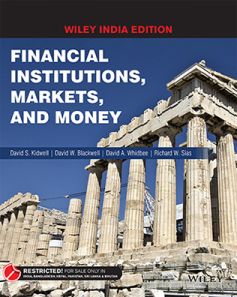Financial Institutions, Markets, and Money
ISBN: 9788126558575
688 pages
For more information write to us at: acadmktg@wiley.com

Description
Kidwell's Financial Institutions 11th Edition presents a balanced introduction to the operation, mechanics, and structure of the U.S. financial system, emphasizing its institutions, markets, and financial instruments. The text discusses complex topics in a clear and concise fashion with an emphasis on "Real World" data and people and event boxes, as well as personal finance examples to help retain topical interest.
Financial Institutions, Markets and Money (11th Edition)
Contents
Part I The Financial System
Chapter 1 An Overview of Financial Markets and Institutions
1.1 The Financial System
1.2 Financial Markets and Direct Financing
1.3 Types of Financial Markets
1.4 The Money Markets
1.5 The Capital Markets
1.6 Financial Intermediaries and Indirect Financing
1.7 Types of Financial Intermediaries
1.8 The Risks Financial Institutions Manage
1.9 Regulation of the Financial System
Chapter 2 The Federal Reserve and Its Powers
2.1 Origins of The Federal Reserve System
2.2 The Current Structure of The Fed
2.3 Monetary Powers of the Board of Governors
2.4 The Fed's Regulatory Powers
2.5 Independence of The Fed
2.6 The Fed's Balance Sheet
2.7 The Fed's Role In Check Clearing
2.8 Federal Reserve Tools of Monetary Policy
Chapter 3 The Fed and Interest Rates
3.1 Federal Reserve Control of The Money Supply
3.2 The Fed's Influence on Interest Rates
3.3 The Treasury Department and Fiscal Policy
3.4 Goals of Monetary Policy
3.5 The Fed and the Economy
3.6 Complications of Monetary Policy
3.7 Anatomy of a Financial Crisis
Part II How Interest Rates Are Determined
Chapter 4 The Level of Interest Rates
4.1 What Are Interest Rates?
4.2 The Real Rate of Interest
4.3 Loanable Funds Theory of Interest
4.4 Price Expectations and Interest Rates
4.5 Forecasting Interest Rates
Chapter 5 Bond Prices and Interest Rate Risk
5.1 The Time Value of Money
5.2 Bond Pricing
5.3 Bond Yields
5.4 Important Bond Pricing Relationships
5.5 Interest Rate Risk and Duration
Chapter 6 The Structure of Interest Rates
6.1 The Term Structure of Interest Rates
6.2 Default Risk
6.3 Tax Treatment
6.4 Marketability
6.5 Options of Debt Securities
6.6 Behavior of Interest Rates over the Business Cycle
Part III Financial Markets
Chapter 7 Money Markets
7.1 How the Money Markets Work
7.2 Economic Role of the Money Markets
7.3 Characteristics of Money Market Instruments
7.4 Treasury Bills
7.5 Federal Agency Securities
7.6 Fed Funds
7.7 Other Major Money Market Instruments
7.8 Money Market Participants
7.9 The Impact of the 2007-2009 Financial Crisis on the Money Markets
Chapter 8 Bond Markets
8.1 Functions of the Capital Markets
8.2 U.S. Government and Agency Securities
8.3 State and Local Government Bonds
8.4 Corporate Bonds
8.5 Financial Guarantees
8.6 Securitized Credit Instruments
8.7 Financial Market Regulators
8.8 Bond Markets Around the World Are Increasingly Linked
8.9 The Impact of the 2007-2009 Financial Crisis on the Bond Markets
Chapter 9 Mortgage Markets
9.1 The Unique Nature of Mortgage Markets
9.2 Types of Mortgages
9.3 Mortgage Qualifying
9.4 Mortgage-backed Securities
9.5 Mortgage Prepayment Risk
9.6 Participants in the Mortgage Markets
9.7 Relationship between Mortgage Markets and the Capital Markets
Chapter 10 Equity Markets
10.1 What Are Equity Securities?
10.2 Equity Markets
10.3 Equity Trading
10.4 Global Stock Markets
10.5 Regulation of Equity Markets
10.6 Equity Valuation Basics
10.7 Equity Risk
10.8 Stock Market Indexes
10.9 The Stock Market as a Predictor of Economic Activity
Chapter 11 Derivatives Markets
11.1 The Nature of Derivative Securities
11.2 Forward Markets
11.3 Futures Markets
11.4 Uses of the Financial Futures Markets
11.5 Risks in the Futures Markets
11.6 Options Markets
11.7 Regulations of the Futures and Options Markets
11.8 Swap Markets
Chapter 12 International Markets
12.1 Difficulties of International Trade
12.2 Exchange Rates
12.3 Balance of Payments
12.4 Foreign Exchange Markets
12.5 Spot and Forward Transactions
12.6 Capital Flows and Exchange Rates
12.7 Government Intervention in Foreign Exchange Markets
12.8 Financing International Trade
12.9 International Money and Capital Markets
12.10 The Globalization of Financial Markets
Part IV Commercial Banking
Chapter 13 Commercial Bank Operations
13.1 An Overview of the Banking Industry
13.2 Balance Sheet for a Commercial Bank
13.3 The Source of Bank Funds
13.4 Bank Uses of Funds: Bank Investments and Cash Assets
13.5 Bank Uses of Funds: Loans and Leases
13.6 Loan Pricing
13.7 Analysis of Loan Credit Risk
13.8 Fee-Based Services
13.9 Off-Balance-Sheet Banking
13.10 Bank Earnings
13.11 Bank Performance
13.12 Bank and Financial Holding Companies
Chapter 14 International Banking
14.1 Development of International Banking
14.2 Regulation of Overseas Banking Activities
14.3 Delivery of Overseas Banking Services
14.4 International Lending
14.5 Foreign Banks in the United States
14.6 Future Directions of International Banking
Chapter 15 Regulation of Financial Institutions
15.1 Reasons for Regulation
15.2 Bank Failures and Regulation
15.3 Safety and Soundness Regulation: Deposit Insurance
15.4 Deposit Insurance Issues
15.5 Safety and Soundness Regulation: Capital Requirements
15.6 Bank Examinations
15.7 Structure and Competition Regulations
15.8 Consumer Protection Regulations
15.9 Bank Regulators
Part V Financial Institutions
Chapter 16 Thrift Institutions and Finance Companies
16.1 Historical Development of Savings Institutions
16.2 Operations of Savings Institutions
16.3 Credit Unions
16.4 Thrift Institutions Around the Globe
16.5 Finance Companies
Chapter 17 Insurance Companies and Pension Funds
17.1 Insurance
17.2 The Insurance Industry
17.3 Life and Health Insurance
17.4 Property and Liability Insurance
17.5 Pensions
Chapter 18 Investment Banking
18.1 The Relationship between Commercial and Investment Banking
18.2 Primary Services of an Investment Bank
18.3 Private Equity
Chapter 19 Investment Companies
19.1 Investment Companies
19.2 Open-end Mutual Funds
19.3 Closed-end Mutual Funds
19.4 Exchange-traded Funds
19.5 Hedge Funds
19.6 Real Estate Investment Trusts
Chapter 20 Risk Management in Financial Institutions
20.1 The Dilemma: Profitability versus Safety
20.2 Liquidity Management
20.3 Managing Credit Risk
20.4 Measuring and Assessing Interest Rate Risk
20.5 Hedging Interest Rate Risk
Summary of Learning Objectives
Key Terms
Questions and Problems
Internet Exercise

